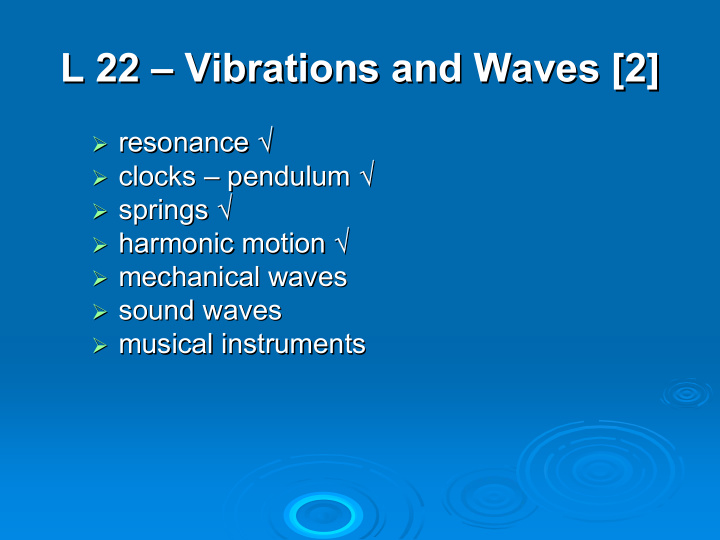



L 22 – – Vibrations and Waves [2] Vibrations and Waves [2] L 22 √ resonance √ � resonance � √ pendulum √ � clocks clocks – – pendulum � √ springs √ � springs � √ harmonic motion √ � harmonic motion � � mechanical waves mechanical waves � � sound waves sound waves � � musical instruments musical instruments �
simple harmonic oscillator mass and spring on a frictionless surface Equilibrium position k A A k is the spring constant, which measures the stiffness of the spring in Newtons per meter
Some terminology • the maximum displacement of an object from equilibrium is called the AMPLITUDE A • the time that it takes to complete one full cycle (A � B � C � B � A ) is called the PERIOD T of the motion • if we count the number of full cycles the oscillator completes in a given time, that is called the FREQUENCY f of the oscillator • frequency f = 1 / period = 1 / T
follow the mass – position vs. time position + A time - A T T T http://www.phys.hawaii.edu/~teb/java/ntnujava/shm/shm.html
simple harmonic oscillator • the period of oscillation is longer (takes more time to complete a cycle) if a bigger mass (m) is used • the period gets smaller (takes less time to complete a cycle) if a stronger spring (larger k) is used π 2 m k • Period T = in seconds • the time to complete a full cycle does not depend on where the oscillator is started (period is independent of amplitude)
Energy in the simple harmonic oscillator • a compressed or stretched spring has elastic potential energy • this elastic potential energy is what drives the system • if you pull the mass from equilibrium and let go, this elastic PE changes into kinetic energy. • when the mass passes the equilibrium point, the KE goes back into PE • if there is no friction the energy keeps sloshing back and forth but it never decreases
Resonance effects • all systems have certain natural vibration tendencies • the mass/spring system oscillates at a certain frequency determined by its When you push a child mass, m and the on a swing you are spring stiffness using resonance to constant, k make the child go higher and higher.
How resonance works • resonance is a way of pumping energy into a system to make it vibrate • in order to make it work the energy must be pumped in at a rate (frequency) that matches one of the natural frequencies that the system likes to vibrate at. • you pump energy into the child on the swing by pushing once per cycle • The Tacoma Narrows bridge was set into resonance by the wind blowing over it
resonance examples • mass on spring • two tuning forks • shattering the glass
Waves • What is a wave? A disturbance that moves through something � rather vague! • The “wave” - people stand up then sit down, then the people next to them do the same until the standing and sitting goes all around the stadium. • the standing and sitting is the disturbance • notice that the people move up and down but the disturbance goes sideways !
Why are waves important? • � waves carry energy � • they provide a means to transport energy from one place to another • the energy from the sun comes to us along electromagnetic waves– light waves
Mechanical waves • a disturbance that propagates through a medium • waves on strings • waves in water – ocean waves – ripples that move outward when a stone is thrown in a pond • sound waves – pressure waves in air
transverse wave on a string • jiggle the end of the string to create a disturbance • the disturbance moves down the string • as it passes, the string moves up and then down • the string motion in vertical but the wave moves in the horizontal (perpendicular) direction • this is a single pulse wave • the “wave” in the football stadium is a transverse wave
How fast does it go? • The speed of the wave moving to the right is not the same as the speed of the string moving up and down. (it could be, but that would be a coincidence!) • The wave speed is determined by: • the tension in the string � more tension � higher speed • the mass per unit length of the string (whether it’s a heavy rope or a light rope) � thicker rope � lower speed
Harmonic waves – keep jiggling the end of the string up and down
Slinky waves • you can create a longitudinal wave on a slinky • instead of jiggling the slinky up and down, you jiggle it in and out • the coils of the slinky move along the same direction (horizontal) as the wave
Homer trips and creates a longitudinal wave
SOUND WAVES • longitudinal pressure disturbances in a gas • the air molecules jiggle back and forth in the same direction as the wave the diaphragm of the speaker moves in and out
Sound – a longitudinal wave
The pressure waves make your eardrum vibrate • we can only hear sounds between 30 Hz and 20,000 Hz • below 30 Hz is called infrasound • above 20,000 is called ultrasound
I can’t hear you Since sound is a disturbance in air, without air (that is, in a vacuum) there is no sound. There is no sound in outer space! vacuum pump
Recommend
More recommend